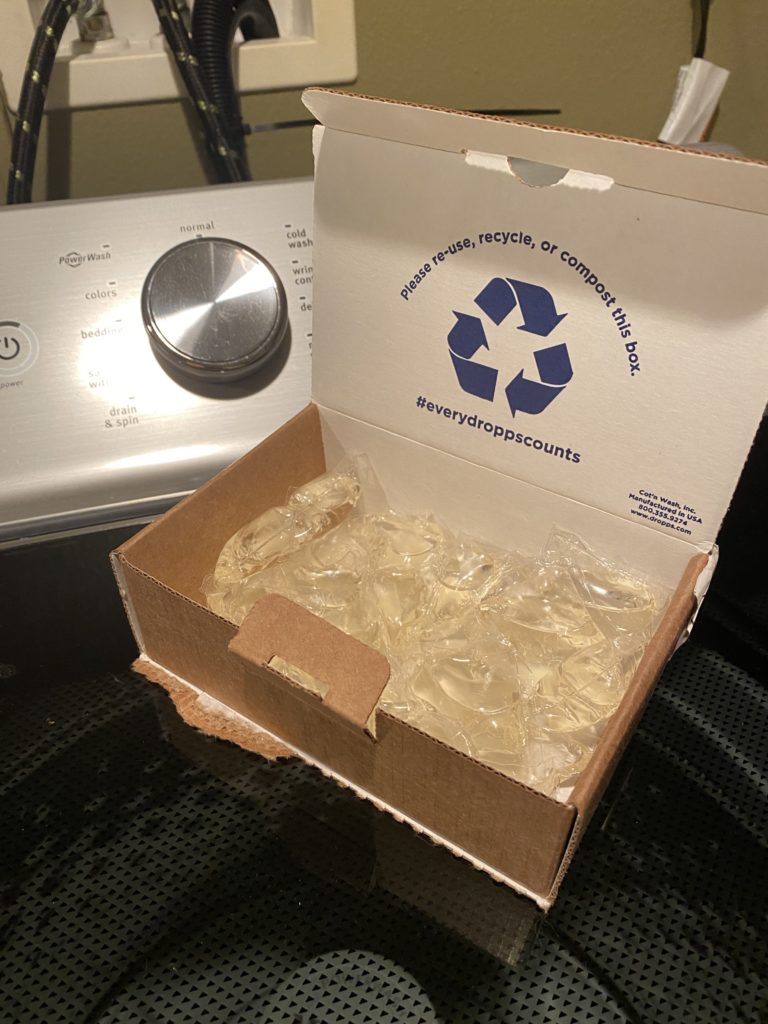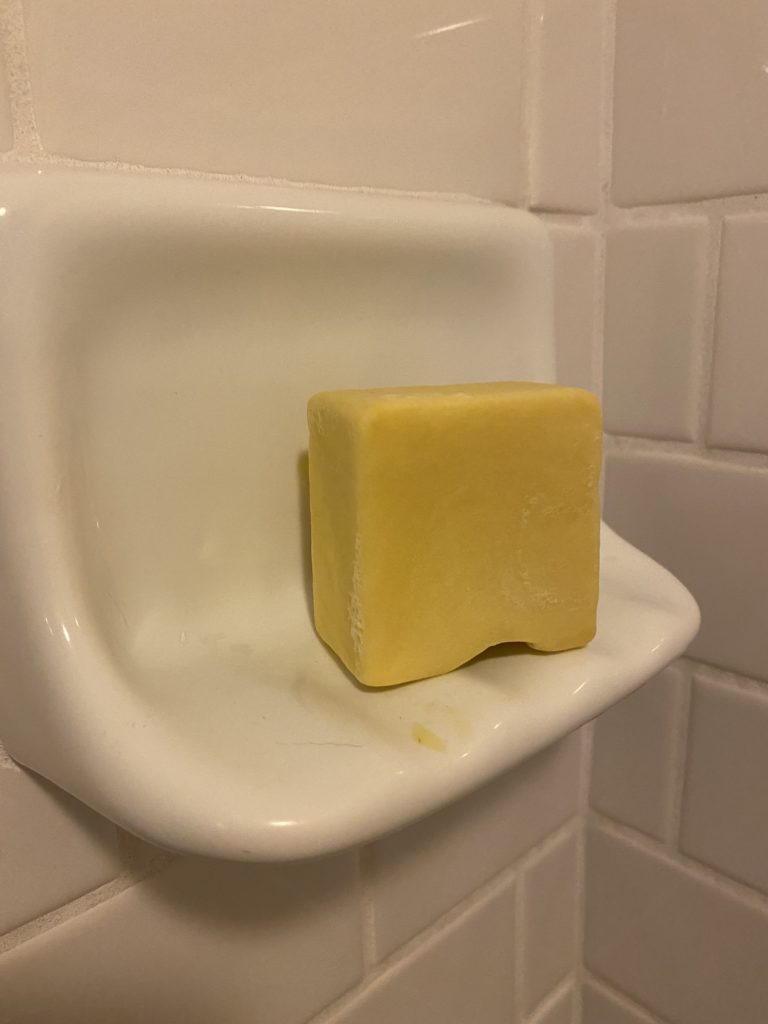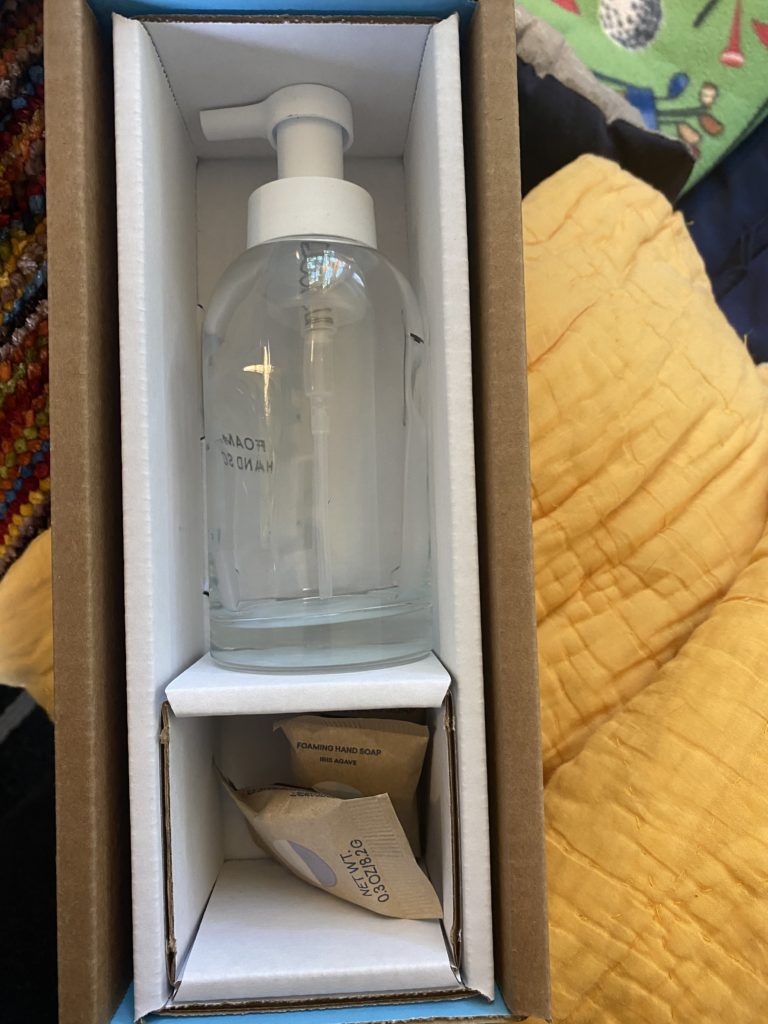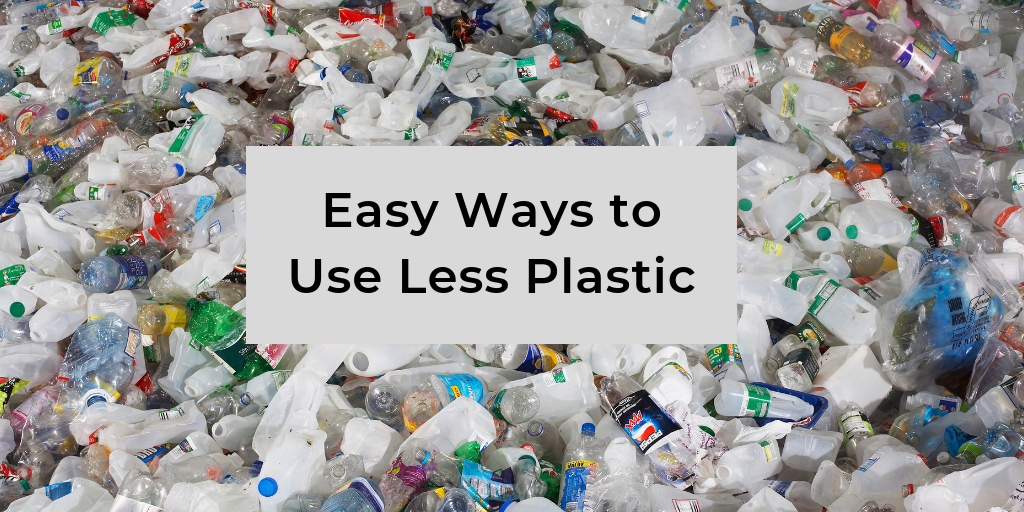Updated July 4, 2022
Sure, it’s August, so I totally missed the boat on posting about #PlasticFreeJuly while it was, you know, July. But in a pandemic where the months all look alike-ish, who cares? Plus prAna just launched #ReshapePackaging and vowed to remove ALL plastic from their packaging stream by 2021–that’s next year! (Much better than The MLM That Will Go Unnamed who has set the goal at 50% reduction of plastic by 2025.) If you want to learn more, check out the Responsible Packaging Movement page and learn how consumers can help make change–even during the pandemic.
Speaking of the pandemic… The pandemic response has me feeling grumpy about the amount of plastic I “have to” use. The grocery store is my grumpy zone. Stores where I live stopped allowing reusable bags–a few won’t even let them into the store!–and switched to paper bags. Then there was a shortage of paper bags due to supply-chain issues, and so all the stores had reusable plastic bags made from thicker plastic…but were still not allowing customers to re-use them. (BTW, I’ve found a way around this: insist on bagging your own groceries. I’ve asked the cashiers to just scan like normal, and then send items down the belt to the bagging area, where I bag my own. My local Fred Meyer has a scan-as-you-go option as well, where you carry a scanner around the store with you, scan each item, then bag it. When you hit check-out, you scan the bar code on the stand and it uploads your order.) Oh and let me be clear: I fully support all efforts to protect grocery workers, including when stores will not allow them to touch my reusable bags. I just don’t need more plastic in my life.
It’s not just the big grocery bags though. Corn on the cob is usually a bulk item you pick out of a gigantic stack, peel a little to make sure the ear isn’t a dud, and then take with you. This year, it’s all pre-wrapped on foam trays. You can’t use your own containers for bulk items at many stores. You can’t use the mesh and reusable produce bags. Even my attempts to support local restaurants have increased my plastic usage as some have switched to all-plastic disposable utensils, and many of the take-out containers have plastic (and pandemic rules won’t allow them to fill my reusable containers). I get that it’s all about safety and reducing potential virus transmission, but it frustrates the part of me that has worked to minimize my single-use plastic consumption.
So I’m doubling-down on avoiding single-use plastic in other areas of my life. As prAna says, “progress, not perfection.”
NEWS FLASH: Something is Better Than Nothing
I’m sure you’ve seen the multitude of websites about the “plastic-free lifestyle.” There’s even an entire book, Plastic Free: How I Kicked the Plastic Habit and You Can Too by Beth Terry (Skyhorse, 2012). (If you haven’t, just run a quick Google search.) Websites like the Plastic Pollution Coalition and My Plastic Free Life even have helpful tips on how to start cutting plastic out of your life. While I think that the “plastic-free lifestyle” is admirable–every bit as much as the “zero waste lifestyle”–I know it’s not a realistic goal for everyone. It’s not for me, either–I wear contact lenses (plastic) that must be cleaned daily (solutions only available in plastic bottles); I take medication (packaging/bottles are plastic). Before you suggest it no, I’m not a candidate for laser eye surgery (I need the lenses to correct my severe astigmatism). Good luck getting the FDA to approve refillable prescription containers.
“Perfect is the enemy of good,” wrote Voltaire, centuries ago. More recently, the New York Times reported that “Life Without Plastic Is Possible. It’s Just Very Hard.” I don’t have to be 100% plastic-free to make a difference, and neither do you. Think about an item of single-use plastic and how much waste it generates. Now imagine that 9 out of 10 times, you choose a re-usable item over a single-use plastic. How much waste is left? What if everyone made similar choices–how much smaller would the pile be?
Target Plastic Bottles for Elimination: THREE Solutions
A ridiculous percentage of the plastic bottles you put into your recycling bin are never recycled. This assumes you live in an area where recycling services are available–plenty of the country still has no recycling. It also assumes that the plastic bottle was theoretically recyclable in the first place–not all plastic is. I’ve read articles that claim up to 50% of what goes into the recycling bin doesn’t get recycled. Check out the “The Violent Afterlife of a Recycled Plastic Bottle,” from The Atlantic–I bet you’ll find it eye-opening. I’m sure you’ve also heard that even more US plastic ends up in the landfill since China started to reject American recycling. (It’s unclear if this is related to the trade wars, but there was definitely a problem with contamination, or non-recyclable items ending up mixed in with the recyclable plastic.) In any case, I’ve targeted plastic bottles for reduction. Here are three easy ways to cut out plastic bottles.
Dropps works as well as any laundry soap should: clean clothes, no weird detergent scent. This is exactly what I wanted. If you prefer a scented laundry detergent, Dropps makes a “fresh scent,” “clean scent,” and a lavender-eucalyptus scent. There are also pods for small loads, and a “baby sensitive skin” (which is somehow different from the “sensitive skin” that I get). If this sounds good to you, head HERE to try Dropps. (That’s an affiliate link, and it gives you $15 off your first order. Savings for you, rewards for me.)

ONE: Laundry Detergent–Get Dropps
The biggest plastic bottles I was bringing into the house? Laundry soap. My theory had been that if I bought the biggest possible bottle, I’d end up using less plastic than if I bought a bunch of smaller bottles. Probably true, but still gigantic plastic bottles. With the anti-dribble spouts I never felt like I was getting all of the detergent out, either. Of course there were all the usual problems too–they’re heavy, they take up space, blah blah blah. Freeing my life from plastic bottles of laundry soap was the easiest thing I did. Even though I only want unscented laundry soap, without any added colors or scents.
When I first tried Dropps, I figured if I didn’t like the way it worked, no big deal. One of those internet ads found me and offered a deal, so I think I paid $5 for my first shipment. When they arrived I was impressed with the packaging: cardboard only, completely recyclable. The detergent itself is in a little plastic-like (but actually plastic-free!) pod. You throw one into the washing machine with the clothing, and that’s it. When all the pods are gone, recycle the box. There’s no other packaging (like the pods are not in a plastic bag inside the box). I’ve been using Dropps almost exclusively since fall 2017, and I’ve only had one shipment with a leaky pod; it was such a non-issue that I didn’t even contact Dropps about it (I just threw out that single pod).
While you can place a single order, you get a better price if you sign up for a subscription. Initially I didn’t think I’d like having a subscription for laundry detergent, but now I love it. Dropps is pretty awesome. You can log in to your account and reschedule to earlier if you’re running low. Dropps sends an email to confirm each shipment, so if you don’t need any laundry detergent you can kick it out a month or two or more. And if you forgot to tell them you moved, you have plenty of time to do so before they ship.(Not that I know from personal experience…) You also get to decide how frequently you want to receive products–it’s not a one-size-fits-all.
Dropps also makes pods that are a scent booster, a fabric softener, oxi booster, and now dishwasher pods (unscented and lemon). Since I originally wrote this post, I used up the last of my big bottle of liquid fabric softener, and switched exclusively to Dropps unscented fabric softener pods. (I have noticed zero difference in my laundry’s softness or static–in other words, I’m getting the same results with Dropps that I got with liquid.) I also switched over to Dropps dishwasher pods. I’m using the lemon/citrus scent, but there are other options (unscented and “fresh rain”).

TWO: Shampoo: try solid shampoo bars
Shampoo bars can be a little weird if you’ve never used them before. I’d say it takes 2-3 shampoos to figure out your best shampoo bar routine. The two biggest things to know: (1) limit rubbing back and forth (at least with my long, straight hair), and (2) anticipate fewer suds.
I say “limit rubbing” because the tendency for most people using a bar product is to rub it. Rubbing a shampoo bar on your hair–at least if you have baby-fine straight hair like mine–is a bad idea. Just like rubbing a towel on your wet hair to dry it is a bad idea. Tangles! Ugh! Instead, rub the shampoo bar in your hands to suds it up, and then transfer the suds from your hands to your hair. I also rub the bar on my hair from the top of the scalp straight down (so no “rubbing” more like one pass) It takes me 2-3 rounds of this to work up enough lather to thoroughly coat my hair and be able to run my fingers through to reach my scalp.
As for suds, at some point in law school I learned that Americans expect their shampoos and soap products to produce a LOT of suds. (Apparently we equate sudsiness with effectiveness.) One dish soap company, for example, had a problem when bottles of a familiar brand of “washing up liquid” (the British term, I guess?) destined for the UK wound up being sold on the American market. There wasn’t anything wrong with the dish soap. British customers do not expect the quantity of suds Americans do, so the product was formulated to produce fewer suds. Americans who bought it were unhappy, because the soap–which was just as soapy, and just as effective at cleaning–did not produce copious suds.
The first shampoo bar I used was from LUSH, a round green thing in a scent called “Karma.” (I later bought various other colors but have no idea what the scents were called.) If you buy it at the store, it has no packaging (though they will typically put it in a little paper bag); if you buy online, it comes packed in a paper bag, in a cardboard box with starch dissolvable packing peanuts. I loved the scent and the way it washed my hair. LUSH sells shampoo bar tins, and I made the mistake of trying to store my shampoo bar in the shower in the tin. Terrible idea–the wet bar sticks to the bottom of the tin and becomes nearly impossible to pull out. The tin is good for storage, and for travel, but let that bar dry before you put it inside! For in-shower storage, your best option is a soap dish with a soap-saver (the little oval thing with the spines that keep your soap from sitting in water), or a wire rack (like on a shower caddy). Ideally, you want to let it dry when not in use so it doesn’t get mushy. LUSH shampoo bars and solid shampoos come in a dozen varieties, and LUSH also makes conditioner bars, but my picky hair did not respond as well. One out of two ain’t bad, right? LUSH also makes solid conditioners, bar soaps, and massage/lotion bars (which I really like!).
The next one I tried was from a company called Ethique that is based in New Zealand. They make square shampoo bars and smaller travel or trial sizes shaped like little hearts. I picked St. Clements as it is made for oily hair. Ethique bars come in paperboard boxes which are, of course, recyclable. As a company, they are committed to zero plastic, including in their shipping materials, and encourage you to #giveupthebottle. They are also committed to ingredient transparency, vegan products, and direct trade. I prefer the square shape of the Ethique bar as it seems easier to hold onto when it is wet and slippery. It’s currently in my shower, so I’m going to count this relationship as a success. Ethique’s shampoo bar box is made from bamboo and sugar cane; the bottom acts as a soap dish with drainage. They also have some cool tips on their website for what to do with itty-bitty pieces, since every product they make is in bar form. Ethique is available from their New Zealand based website, at many Target locations, from Target.com, and from other online retailers. In addition to shampoo, they also make bar conditioners, face cleansers, body soaps, and lotion/massage bars.
I’ve since tried several other shampoo bars, and stocked up on the Vunella brand when they had a good sale. (Box is recyclable paperboard.) These are nice, thick, round bars that seem a little harder (and seem to last a little longer) than the others I’ve tried. My favorite is the coconut lime, but I also have citrus and lavender.
Shampoo bars may seem expensive when you’re pricing them. (At LUSH they run approx. $12-15 each for a 1.9 ounce bar, though a few are 3.5 ounce bars; a full-sized Ethique is $16 for a 110 gram bar which is approx. 3.9 ounces, a sample is $4; Vunella has bundles and frequent sales, and I’d estimate I paid $7-12 per bar) They typically last at least as long as 3 bottles of shampoo, provided you don’t let them get soggy. Depending on how you use them and care for them, shampoo bars can last much longer. So whether they are expensive depends on how much you are paying per bottle of shampoo. I don’t wash my hair every day (though on workout days I might wash it twice), and I’d say a bar lasts 3-5 months. There are plenty of other choices out there, but these are three of the ones that I have tried and can personally recommend.

THREE: Hand Soap Swap: Blueland (bonus swap: toilet cleaner!)
Hand soap seems like an easy thing to swap out–just use bar soap right? If you’ve got a pedestal sink with a sculpted-in “soap dish” like I do, not so much. (That “soap dish”? First it gets slippery and the soap just slides into the sink constantly. Then as soap builds up it get gooey and keeps the soap wet. Messy!) Or maybe you’ve got kids who can’t be trusted to put the soap back, or who leave it covered in sandbox dirt or blue Kool-Aid mix or something. There are a million reasons why someone might choose liquid soap, but it comes with those plastic bottles.
Enter Blueland. When I ordered this, I just decided to go all-in: I ordered one for the kitchen, and one for the first floor bathroom, and enough refillls to last for a year. Fingers crossed, right? When the package came, I was pleasantly surprised to find zero plastic (other than the pump in the bottle). No plastic tape, no plastic wrap, no plastic padding, nada.
It’s pretty easy after you unbox: fill the glass bottle with water, drop a tablet in, watch it fizz. Once it’s done, add the pump top.
One thing though, you do have to re-set your expectations, and maybe your hand-washing routine. If you’re like me, you’re used to pumping the soap onto your hands, running them under water, and then rubbing them together to lather. STOP.
New plan: pump this foaming soap onto your hands, rub them together to soap them up with the foam, and THEN run them under the water. This soap isn’t super thick–it comes out of the pump as foam!–so you don’t need water to make it spreadable. It took me a little while to adopt this new habit, but once I did, I loved this hand soap It smells nice (I got a variety of replacement tablets). A single tablet lasts a long time, and as I predicted when I first bought them, I did not have to re-order until 2021. I now have Blueland soap at all four of the sinks in my house, and the tablets take up very little space in my cabinet.
Speaking of Blueland and my cabinet, in 2021 I also switched to their toilet-cleaning tablets. One package fills the lavender storage tin. To use: put tablet into toilet bowl, wait a little while it dissolves, scrub with the toilet brush, and flush. I bought a tin for each bathroom, and these work every bit as well as liquid cleaner that comes in bottles, or the tablets that come in the non-recyclable plastic packaging.
One reason manufacturers use plastic bottles for their products is the cost of the bottle (plastic is cheap, glass is more expensive). In addition, the transportation costs for glass are higher, because glass weighs more than plastic (freight charges are based on weight). Glass bottles for many products now packaged in plastic need to be thicker to make them less prone to shatter or break, especially since most are used in the bathroom or kitchen. So if a manufacturer switches a product to glass packaging, it makes sense to also make the glass reusable, so it only gets shipped once. That leads logically to shipping refills, and if you’re trying to avoid plastic that means finding a way to take the water out of the product.
